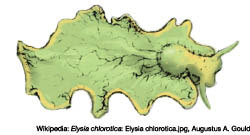

 I have often kidded my biologist
friends that the only rule that ever works in biology is “for every
situation that exists in biology, there is always an exception.”
Another example of that concept has shown up as researchers have
discovered a sea slug that can make its own chlorophyll and turn light
into energy.
I have often kidded my biologist
friends that the only rule that ever works in biology is “for every
situation that exists in biology, there is always an exception.”
Another example of that concept has shown up as researchers have
discovered a sea slug that can make its own chlorophyll and turn light
into energy.
The animal’s scientific name is Elysia
chlorotica and its common name is the eastern emerald elysia. It
is found along the east coast of the United States.
This slug is able to manufacture the most common form of chlorophyll,
the green pigment in plants that captures energy from sunlight. The
chloroplasts the slug uses come from green algae called Vaucheria
litorea. Once the slug eats enough of the algae the chloroplasts from
the algae generate energy for the slug for the rest of its life — so it
never has to eat again! The slug is then able to capture energy from
the sun by the process of photosynthesis as plants do.
Scientists studying the process have found that there are at least 15
chemical reactions and the cooperation of multiple cell components to
make this happen. The slug actually holds the chloroplasts within its
cells and they work in light, but not in dark environments. The slug’s
life is greatly simplified by this plant-like nature. Since it only has
to eat once in its life, the condition of the algae is only critical
during the first meal, and the lack of mobility is not an issue for the
slug.
Gary Martin, one of the researchers studying the slug called the animal
“Bizarre, … Steps in evolution can be more creative than I ever
imagined.” We would suggest that an intelligence is what was the
creative force in this complex, simple animal. God’s designs continue
to amaze us as we look at the wonder-working hand that has gone before
us.
Source of data: Science News,
February 13, 2010, page 10.
Back to
Contents
Does God Exist?, MayJun11.



 I have often kidded my biologist
friends that the only rule that ever works in biology is “for every
situation that exists in biology, there is always an exception.”
Another example of that concept has shown up as researchers have
discovered a sea slug that can make its own chlorophyll and turn light
into energy.
I have often kidded my biologist
friends that the only rule that ever works in biology is “for every
situation that exists in biology, there is always an exception.”
Another example of that concept has shown up as researchers have
discovered a sea slug that can make its own chlorophyll and turn light
into energy.